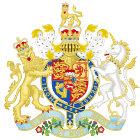Levy en Masse Act 1803 facts for kids
| Act of Parliament | |

|
|
| Long title | An Act to amend and render more effectual, an Act passed in the present Session of Parliament, intituled, An Act to enable His Majesty to provide for the Defence and Security of the Realm during the present War, and for indemnifying Persons who may suffer in their Property by such Measures as may be necessary for That Purpose; and to enable his Majesty most effectually and speedily to exercise his ancient and undoubted Prerogative in requiring the Military Service of his liege Subjects in case of Invasion of the Realm. |
|---|---|
| Citation | 43 Geo 3 c 96 |
| Introduced by | Charles Philip Yorke (Commons) |
| Territorial extent | Great Britain |
| Dates | |
| Royal assent | 27 July 1803 |
| Repealed | 16 July 1806 |
| Other legislation | |
| Amends | Defence of the Realm Act 1803 |
| Amended by | Levy en Masse Amendment Act 1803 |
| Repealed by | Defence of the Realm Act 1806 (46 Geo 3 c 90) |
|
Status: Repealed
|
|
| Text of statute as originally enacted | |
The Levy en Masse Act 1803 (also known as 43 Geo. 3 c. 96) was a law passed by the Parliament of the United Kingdom. It was meant to help defend Great Britain during a time of war. This Act made it possible for the government to ask many men to join the military.
Even though it seemed like an update to an older law, the Defence of the Realm Act 1803, it was actually a big new law. It required local areas in Great Britain to make lists of men for military training. It also explained how this training would happen. However, the Act also said that if enough men joined volunteer groups, the forced training could be stopped. Many people volunteered, so the compulsory training was never actually used.
Contents
What the Act Required
This law brought back an old idea called posse comitatus. This meant that ordinary citizens could be called upon to help defend the country. The Act set up a detailed plan for military training in every local area in Britain.
Who Was Included?
The law stated that local leaders, called lords-lieutenant and their helpers, had to list all men between 17 and 55 years old. Some people were not included, such as:
- Clergymen (religious leaders)
- Quakers (a religious group)
- Schoolteachers
- People who were too sick or weak to serve
How Men Were Grouped
The men on the list were then put into four different groups:
- Group 1: Unmarried men under 30 with no children under 10.
- Group 2: Unmarried men between 30 and 50 with no children under 10.
- Group 3: Married men between 17 and 30 with no more than two children under 10.
- Group 4: All other men not in the first three groups.
Once grouped, these men would be trained and given weapons. If an invasion happened, they could be called to serve anywhere in the British Isles.
How the Act Became Law
Charles Philip Yorke, who was the Secretary at War at the time, introduced this law. He called it the 'Military Service Bill'. It was presented on 18 July 1803. The law moved very quickly through Parliament and became official on 27 July.
Key Dates for the Bill
- House of Commons:
- Ordered and presented: 18 July 1803
- Discussed and reported: 18 July 1803
- Re-discussed: 20 July 1803
- Passed by the Commons: 22 July 1803
- House of Lords:
- Changes made: 26 July 1803
- Changes agreed to: 26 July 1803
- Royal Assent:
- Became law: 27 July 1803
Why Training Never Happened
The main goal of the Act was to get more people trained for defense. However, the government never actually had to force people into training. This was because a huge number of people volunteered to join military groups on their own.
Changes to the Act
| Levy en Masse Amendment Act 1803 | |
|---|---|
| Act of Parliament | |

|
|
| Long title | Act to amend an Act made in this present Session of Parliament intituled An Act to amend and render more effectual an Act passed in the present Session of Parliament intituled An Act to enable his Majesty more effectually to provide for the Defence and Security of the Realm during the present War and for indemnifying Persons who may suffer in their Property by such Measures as may be necessary for that Purpose and to enable his Majesty more effectually and speedily to exercise his ancient and undoubted Prerogative in requiring the Military Service of his liege Subjects in case of Invasion of the Realm. |
| Citation | 43 Geo 3 c 120 |
| Territorial extent | Great Britain |
| Dates | |
| Royal assent | 11 August 1803 |
| Text of statute as originally enacted | |
The Levy en Masse Act was changed by another law called the Levy en Masse Amendment Act 1803 (43 Geo. 3 c. 120). This amendment was passed on 11 August 1803. It said that if the King was happy with the number of volunteers in a certain area, he could stop the Levy en Masse Act from being used there. This was allowed even if the number of volunteers was less than three-fourths of the first group of men listed.

